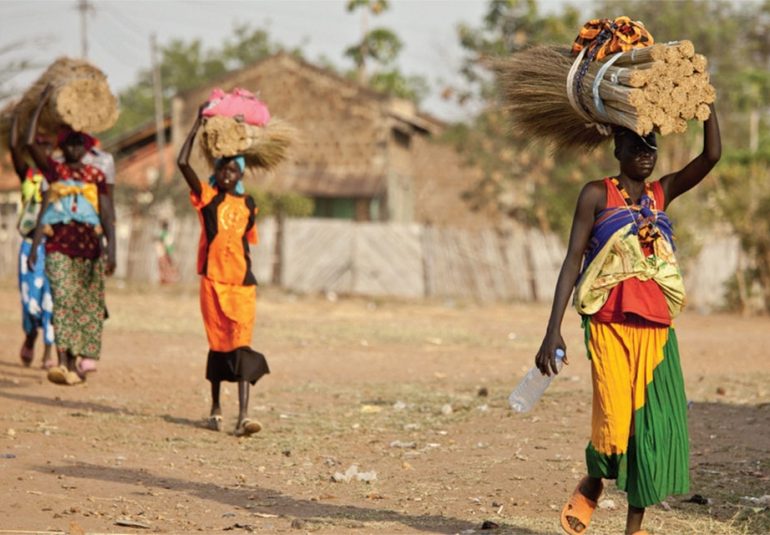A year ago, FORBES GEORGIA published an article about the world’s 10 fastest-growing economies in 2017 / 2018. Now let’s look at the fastest-growing economies in 2019.
Six of the ten countries discussed in last year’s article are present in the top 10 in 2019. These are Ethiopia, Cote d’Ivoire, Bangladesh, Ghana, Nepal and Cambodia.
The article uses figures obtained from the International Monetary Fund. The IMF regularly publishes economic forecasts for its member states. The 2019 forecast was updated approximately one month ago, thereby coming close to actual figures for the year.
The global economy is forecast to grow by 3% by the end of 2019. The economic growth figure will be 1.7% in developed countries and 3.9% in developing countries. The developing countries of Asia constitute the fastest-growing region, with an average annual growth figure of 5.9%.
Countries that made it into the top 10 have posted economic growth figures of 6.5% or more. It must be said that a country’s initial position plays a significant role in achieving high growth rates; it is much easier to achieve high growth in poorer countries, and this happens due to untapped resources, weak domestic competition, relatively high profit margins and low per-capita income economy.
10. Mauritania
Population: 4.1 million
GDP: $5.7 billion
GDP per Capita: $1,390
The economy of Mauritania will grow by 6.6% by the end of this year. Mauritania is situated in western Africa, and 75% of its territory is covered by the Saharan desert. Even though it now has the world’s tenth-fastest growing economy and has achieved average annual economic growth of 4.1% over the last eight years, it remains an extremely poor country, ranking 142nd in the world in terms of GDP per capita. In spite of the poverty, the country’s population has increased by 17% during the last eight years.
Mauritania has rich deposits of precious and black ferrous metals. Various metal ores account for half of the country’s exports. Mauritania has also started exporting natural gas, which has accelerated its economic growth.
9. Cambodia
Population: 16.5 million
GDP: $27 billion
GDP per Capita: $1,620
The economy of Cambodia will grow by approximately 7% in 2019. Cambodia is still trying to overcome extreme poverty, and despite achieving average annual economic growth of 7.2% over the last eight years, it still ranks 137th in terms of per-capita income. The country’s population is also growing rapidly.
Cambodia’s economic growth is fueled by its cheap workforce, improvements in agricultural technologies and foreign aid. The fastest-growing sectors are construction, export and tourism. The state budget expenditure in relation to the country’s GDP is 25%, while government debt is 30% of the country’s GDP. The average inflation rate was 2.6% over the last five years.
8. Nepal
Population: 28.5 million
GDP: $30 billion
GDP per Capita: $1,050
The economy of Nepal will grow by 7.1% by the end of this year, and the country will retain its place in the global ‘top 10′ for the third successive year. Like Mauritania and Cambodia, Nepal is also one of the world’s poorest countries, ranking 155th in terms of GDP per capita.
During the past three years, Nepal’s fast economic growth has been fueled primarily by significant foreign aid that the country received in the aftermath of the devastating earthquake in 2015. The country’s dominant sector is tourism. Even though only 20% of the country’s land is arable, more than half of the population is employed in agriculture. Money transfers by Nepalese migrants from abroad account for 29% of the country’s GDP.
7. Ethiopia
Population: 96 million
GDP: $91 billion
GDP per Capita: $950
The economy of Ethiopia will grow by 7.4% in 2019. Although the country’s economy has been growing by an average of 9% over the last eight years, Ethiopia is still extremely poor, ranking 164th in terms of GDP per capita. Attempts to emerge from extreme poverty are partly hindered by the population boom. The country’s population is growing by several million people each year, jumping from 86 million in 2012 to 96 million in 2019.
Ethiopia’s fast economic growth is largely fueled by its cheap workforce. Approximately 70% of the population are below the age of 30. Ethiopia is the world’s third-largest coffee producer and has rich hydro power resources, creating potential for the country to become one of the largest exporters of electricity in Africa and the Middle East. Growth rates are high in the construction and service sectors, partly thanks to government projects.
6. Ghana
Population: 30 million
GDP: $67 billion
GDP per Capita: $2,220
The economy of Ghana will grow by 7.5% by the end of 2019. Ghana is approximately twice as poor as Georgia, though its economy has been growing at an average rate of 6% over the last eight years. Ghana is characterized by high inflation (9% year on year), high budget deficit and growing state debts, which largely negate the fast-economic growth.
Ghana is a democratic country where the official state language is English. The country’s main exports are cocoa, gold and oil; accounting for approximately 75% of total exports. Fast-economic growth is primarily fueled by the oil sector. Oil production in Ghana has increased significantly since 2011.
5. Cote d’Ivoire
Population: 25.6 million
GDP: $44 billion
GDP per Capita: $1,700
With an economic growth rate of 7.6%, Cote d’Ivoire ranks fifth in the world this year. The country’s economy began growing fast in 2012. It grew by an average of 8.5% between 2012 and 2019. Like many other African countries, Cote d’Ivoire has a booming population, which has grown by 20% since 2012.
Cote d’Ivoire is a francophone West African country. Prior to 2011, it was affected by political and economic crises for over a decade, plunging the country into deep poverty. However, since 2011, Cote d’Ivoire has been characterized by political stability. The government has initiated large-scale infrastructural projects, significantly accelerating economic growth. Like in many other poor countries, agriculture holds a large share in the economy. State budget expenditure as a percentage of the country’s GDP is 23%, while inflation is low (an average annual rate of 1.1% over the last eight years).
4. Bangladesh
Population: 167 million
GDP: $317 billion
GDP per Capita: $1,900
The economy of Bangladesh will grow by 7.8% in 2019. Its per-capita GDP has doubled over the last eight years, but it remains a poor country due to a demographic boom. Bangladesh is the world’s eighth-most populous country and has the highest population density outside city-states.
The budget expenditure of Bangladesh amounts to 15% of the GDP. The country’s state debts are low. The volume of exports and imports is virtually equal, so there is no trade deficit.
Bangladesh has largely achieved fast economic growth through its cheap workforce. This is particularly evident in the clothing production industry, where low labor costs have resulted in a competitive advantage. Bangladesh is the world’s second-largest exporter of clothes, trailing only China. Money transfers by Bangladeshis living abroad also significantly helps the country’s economy.
3. Rwanda
Population: 12.4 million
GDP: $10.2 billion
GDP per Capita: $825
The economy of Rwanda will grow by 7.8% in 2019. Over the last eight years, the country’s economy grew by an average of 7.1%. However, due to the demographic boom, Rwanda is only slowly emerging from extreme poverty, and is currently ranked 166th in the world in terms of GDP per capita.
Rwanda’s road towards development is an interesting one. This is a small country that has few natural resources and suffered the horrors of genocide in the 1990s. Although democracy is weak in Rwanda, women currently hold 67% of seats in the parliament, which is a global record. Reforms have enabled Rwanda to reach 32nd spot in the Index of Economic Freedom and 29th spot in the Doing Business Index. According to the Index of Economic Freedom, Rwanda offers better property protection than Georgia and is less corrupt, as well as has a considerably more effective and freer judiciary system. Rwanda has become attractive for investors, although state investments also play a significant role in achieving economic growth. Rwanda’s government debts are, therefore, growing fast and turning into a risk factor.
2. South Sudan
Population: 13.4 million
GDP: $3.7 billion
GDP per Capita: $275
The economy of South Sudan will grow by 7.9% by the end of the year, but the country ranks 178th in the world in terms of GDP per capita. South Sudan achieved independence from Sudan in 2011. The country was ravaged by a civil war between 2013 and 2018, with 400,000 people losing their lives, millions more leaving the country, and the economy in ruins. Per capita GDP fell from $1,300 to $275. Inflation between 2015 to 2017 was 700%, while the value of the national currency against the U.S. dollar fell by a staggering 1000%.
The high economic growth rate that has been achieved in 2019 is a result of peace and positive economic trends. The inflation rate has been reduced considerably, but still amounts to 35% for the year. Generally speaking, countries achieve rapid economic growth after the end of armed conflicts, as they have to start from a position of economic standstill. South Sudan has significant oil reserves that have yet to be exploited due to war.
1. Dominica
Population: 73 million
GDP: $0.6 billion
GDP per Capita: $8,400
The economy of Dominica will grow by 9.4% in 2019, thereby topping this list. The past seven years have been quite unsuccessful for the country. For example, its economy shrank by 9.5% in 2017. Dominica is the richest among the countries discussed in this article, although it still only ranks 107th in the world in terms of GDP per capita.
Dominica is a small island country in the Caribbean that is known for offshore financial services, tourism and exporting exotic fruits. It is the world’s ninth-largest exporter of bananas. As the country depends significantly on tourism and agriculture, its economy is badly affected by natural disasters. Hurricane Maria inflicted substantial economic damage on Dominica in 2017. It could be said that the rapid economic growth that we have witnessed in 2019 is a result of recovery from the effects of Maria.














